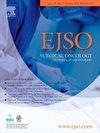时间问题:同步和异时乳房成形术技术的比较分析
IF 3.5
2区 医学
Q2 ONCOLOGY
引用次数: 0
摘要
背景:治疗性乳房成形术(TM)是一种二级肿瘤成形术,可改善乳腺癌保乳手术(BCS)患者的美容效果。对侧复位可以与索引过程同时进行(同步)或更晚进行(异时);后者的常见原因包括较少的并发症、较少的翻修手术需求和较少的辅助治疗延迟。本研究的目的是比较同步和同步方法治疗乳房成形术。材料与方法手工检索2010 - 2019年的数据库。主要观察指标为同步手术与单侧手术的逐年趋势。次要结局指标包括人口统计学变量、乳房成形术类型、肿瘤生物学、修正手术率、计划修正手术的类型和时间、并发症、辅助治疗的类型和时间、腋窝手术的类型和每年的肿瘤趋势。结果同期隆乳155例,单侧隆乳107例,其中对侧延迟对称隆乳26例。TMs总数显著增加(p <;0.03)和同步TMs (p <;0.02)随着时间的推移。化疗时间无差异(p >;0.05)、放疗时间(p >;0.05)或距再次切除乳缘/乳房翻修术的时间(p >;0.05)。单侧组对侧对称手术平均时间为14个月。结论同步TMs越来越受欢迎,并且对于接受BCS治疗的乳腺癌患者是安全的。需要进一步的工作来确定两组患者的偏好。本文章由计算机程序翻译,如有差异,请以英文原文为准。
Timing matters: A comparative analysis of synchronous and metachronous mammoplasty techniques
Background
Therapeutic mammoplasty (TM) is a Level 2 oncoplastic procedure that improves cosmetic outcome in patients undergoing breast conserving surgery (BCS) for breast cancer. The contralateral reduction may be performed at the same time as the index procedure (synchronous) or later (metachronous); commonly cited reasons for the latter include fewer complications, reduced need for revisional surgery and less delay to adjuvant therapies. This study aims to compare synchronous and metachronous approaches to therapeutic mammoplasty.
Materials and methods
A database between 2010 and 2019 was hand searched. The primary outcome measure was the trend of synchronous vs unilateral operating by year. Secondary outcome measures included demographic variables, type of mammoplasty, tumour biology, revisional surgery rate, type and timing of planned revisional surgery, complications, type and time to adjuvant therapy, type of axillary surgery, and tumour trends by year.
Results
155 patients had synchronous mammoplasties and 107 patients had unilateral procedures, of which 26 had delayed contralateral symmetrising surgery. There was a significant increase in the total number of TMs (p < 0.03) and synchronous TMs (p < 0.02) over time. There were no differences in time to chemotherapy (p > 0.05), time to radiotherapy (p > 0.05) or time till re-excision of margins/revision mastectomies (p > 0.05). In the unilateral group, mean time to contralateral symmetrising surgery was 14 months.
Conclusions
Synchronous TMs are increasingly popular and appear safe for patients undergoing BCS for breast cancer. Further work is necessary to establish patient preferences between the two groups.
求助全文
通过发布文献求助,成功后即可免费获取论文全文。
去求助
来源期刊

Ejso
医学-外科
CiteScore
6.40
自引率
2.60%
发文量
1148
审稿时长
41 days
期刊介绍:
JSO - European Journal of Surgical Oncology ("the Journal of Cancer Surgery") is the Official Journal of the European Society of Surgical Oncology and BASO ~ the Association for Cancer Surgery.
The EJSO aims to advance surgical oncology research and practice through the publication of original research articles, review articles, editorials, debates and correspondence.
 求助内容:
求助内容: 应助结果提醒方式:
应助结果提醒方式:


